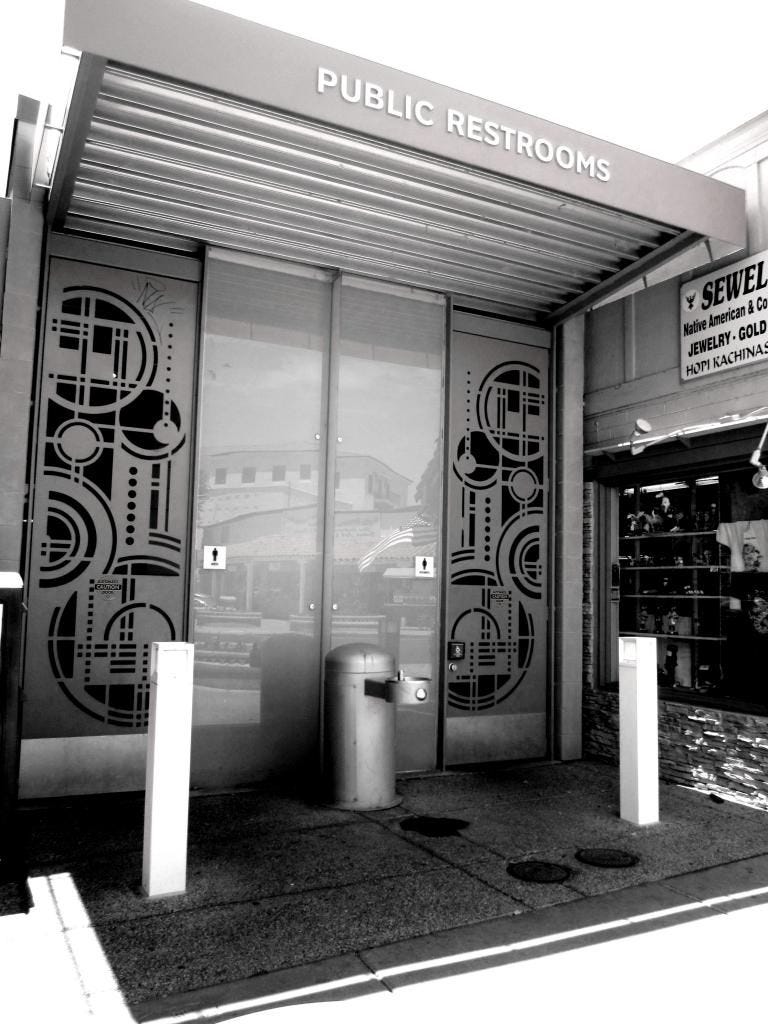Satoshi's Sidewalk #18: Public Places
Public places and public spaces were approached with care and class. Now you're afraid you'll be shot dead while wiping your ass.
Public spaces were once held in high regard. Specifically because they were public. People passed through, stopped to socialized, conduct business, and loiter. Or just do whatever struck their fancy.
With public spaces being frequented and visible to (potentially) the entire city and any visitors there was an emphasis on making those spaces beautiful. If everyone has to see it, and if anyone can enjoy it, why not build it to last and with aesthetic care?
As the Twitter meme goes:
How it started…
How it’s going…
To save dear subscribers from spending the mental energy of guessing the interior of the public restroom, I’ll just tell you. Its unpainted cinderblocks and concrete flooring accompanied by stainless steel sinks, toilets, and stalls. And the cheapest, uncleaned lighting fixtures you can imagine. Typical design and construction standards for public restrooms the last few decades.
Aside from the Indianapolis public restroom being transphobic (and racist, mind you!), the design is an attempt to create a timeless space for a never-ending purpose.
If you’ve got to go, you might as well go somewhere nice. We’re short such options today. The vibe of public restrooms is closer to texting your friend a reminder to delete your browser history before entering and attempting the quickest bathroom stop on record - and only because you literally can’t wait.
Does the Indianapolis design make you feel that way? The subconscious queues don’t put out the same feelings of expediency. The design emanates a purpose with decency and class. Hence the design being called a Public Comfort Station.
Why invest so much time in designing and building public bathrooms in the middle of a street? Is such an endeavor a justifiable use of public funds? Why not?
Public spaces, and their quality, are direct reflections of the wealth accumulated by individuals residing in a city. The greater the wealth, the greater the public spaces. Citizens will spend extra to beautify their locales given it doesn’t impact their wealth.
Strong Towns writes about the “sweet spot” of supporting infrastructure to be about 2-4% annually of the estimated monetary value of the land. Purchasing power of hard money increases over time with better technology and economic productive gains (fancy way to say goods cost less over time because markets). Increased purchasing power allows cities to build (and maintain) nicer, better, and aesthetically appealing infrastructure. The cost of methods and materials previously used for, say, public comfort stations, decreases over time or “upgrades” become more affordable. If cities or private individuals (public restrooms were often privately owned) are willing to up the ante to create a better public space they could afford to do so.
This is part of the miracle of decreasing prices with hard money over time. Inflationary monetary systems work in the opposite manner. The dinky public restroom pictured above may have cost a million dollars. I could look it up but don’t want to be disappointed. You get what I’m saying. What is the likelihood the Indianapolis Public Comfort Station cost the equivalent of $1,000,000?
Fix the money, fix the public spaces.










Enjoyed the use of the "how it started, how it's going" meme!